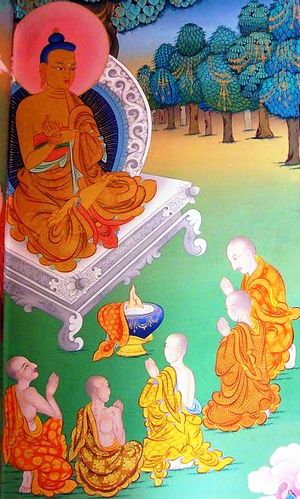Four Noble Truths

The Four Noble Truths (Skt. catvāryāryasatyā; Tib. འཕགས་པའི་བདེན་པ་བཞི་, pakpé denpa shyi, Wyl. 'phags pa'i bden pa bzhi) or the Four Realities of the Aryas, were taught by Buddha Shakyamuni as the central theme of the so-called first turning of the wheel of the Dharma after his attainment of enlightenment. They are:
- the truth (or reality) of suffering (Skt. duḥkha-satya; Tib. སྡུག་བསྔལ་གྱི་བདེན་པ་) which is to be understood,
- the truth (or reality) of the origin of suffering (Skt. duḥkha-samudaya-satya; Tib. ཀུན་འབྱུང་བའི་བདེན་པ་), which is to be abandoned,
- the truth (or reality) of cessation (Skt. nirodha-satya; Tib. འགོག་པའི་བདེན་པ་), which is to be actualized, and
- the truth (or reality) of the path (Skt. mārga-satya; Tib. ལམ་གྱི་བདེན་པ་), which is to be relied upon.[1]
Meaning of the Term
In his Clear Words commentary, Chandrakirti says:
- Therefore, since it is true only for the noble ones, it is called the truth of the noble ones.[2]
In his General Topics commentary on the Abhisamayalankara, Patrul Rinpoche explains:
- The Compendium on Determinations[3]says:
- What is the meaning of "truth"? It has the characteristic of not being in discord with the teachings,
- And when seen it becomes the cause for complete purity. That is the meaning of "truth".
The meaning of the first line refers to the object, that is, exactly as the Tathagata has taught [objects] to be impermanent and so on, that is how they are. The latter refers to the subject, that is, when [objects] are seen exactly as they are, an unmistaken mind is produced. That is the meaning of the term "truth" by itself.
As for the meaning of "the truths of the noble ones", since the noble ones see the truths exactly as the truths are, both their mind and the object [perceived] are true. Therefore they are [the truths] of the noble ones.
For childish beings, although in reality things are "true", since their minds do not realize this [reality], it is not presented as truth.
Cause & Effect
The four truths can be divided into two pairs of cause and effect, known as the cause and effect of 'thorough affliction' or samsara, and the cause and effect of 'complete purification' or nirvana.
Sixteen Aspects of the Four Noble Truths
Suffering
1. Suffering (Skt. duḥkha; Tib. སྡུག་བསྔལ་བ་)
2. Impermanence (Skt. anitya; Tib. མི་རྟག་པ་)
3. Emptiness (Skt. śūnyatā; Tib. སྟོང་པ་ཉིད་)
4. Selflessness (Skt. anātmaka; Tib. བདག་མེད་པ་)
Origination
5. Cause (Skt. hetu; Tib. རྒྱུ་)
6. Origination (Skt.samudaya; Tib. ཀུན་འབྱུང་)
7. Intense Arising (Skt. prabhava; Tib. རབ་སྐྱེ་)
8. Condition (Skt. pratyaya; Tib. རྐྱེན་)
Cessation
9. Peace (Skt. śānta; Tib. ཞི་བ་)
10. Cessation (Skt. nirodha; Tib. འགོག་པ་)
11. Perfection (Skt. praṇīta; Tib. གྱ་ནོམ་པ་)
12. True Deliverance (Skt. niḥsaraṇa; Tib. ངེས་འབྱུང་, Wyl. nges 'byung)
Path
13. Path (Skt. mārga; Tib. ལམ་)
14. Appropriate (Skt. nyāya; Tib. རིགས་པ་)
15. Effective (Skt. pratipatti; Tib. སྒྲུབ་པ་)
16. Truly Delivering (Skt. nairyāṇika; Tib. ངེས་འབྱིན་)
Tibetan Texts
We find the classical presentation of these four truths embedded in no fewer than seven individual works in the Kangyur[4]:
- The Chapter on Schism in the Sangha (Skt. Saṅghabhedavastu), Toh 1-17.
- Foundations of the Minor Monastic Discipline (Skt. Vinayakṣudrakavastu), Toh 6.
- The Sutra on Going Forth (Skt. Abhiniṣkramaṇasūtra), Toh 301.
- The Sutra of the Wheel of Dharma (Skt. Dharmacakrasūtra), Toh 337.
- The Sutra of the Turning of the Wheel of Dharma (Skt. Dharmacakrapravartanasūtra), Toh 31, translated from the Pali Canon.
- The Hundred Deeds (Skt. Karmaśataka), Toh 340.
- The Play in Full (Skt. Lalitavistara), Toh 95.
Oral Teachings Given to the Rigpa Sangha
- His Holiness Sakya Trizin, Paris, 15 September 1996
- Ringu Tulku Rinpoche, Dzogchen Beara, Ireland, 31 May-3 June 2002
- Sogyal Rinpoche, Haileybury retreat, UK, 9-11 April 2013
- Chagdud Khadro, Dzogchen Beara, 25-27 May 2018
- Ringu Tulku Rinpoche, Dzogchen Beara, 12 July 2024
Further Reading
- Chögyam Trungpa, The Truth of Suffering and the Path of Liberation (Shambhala, 2009)
- The Dalai Lama, His Holiness, Buddha Heart, Buddha Mind: Living the Four Noble Truths (The Crossroad Publishing Company, 2000)
- The Dalai Lama, The Four Noble Truths (Thorsons, 1998)
- The Dalai Lama, Kindness, Clarity and Insight (Snow Lion Publications, 2006), pages 29-34
- The Dalai Lama, Lighting the Way (Snow Lion Publications, 2004), Chapter 1
- The Dalai Lama, The Middle Way (Wisdom Publications)
- Dharmachakra Translation Committee,
 The Sūtra of the Wheel of Dharma, Introduction
The Sūtra of the Wheel of Dharma, Introduction - Geshe Tashi Tsering, The Four Noble Truths (Wisdom, 2005)
- Jamgön Mipham Rinpoche, Gateway to Knowledge, VOL II (Hong Kong, Boudhanath & Esby: Rangjung Yeshe Publications, 2000)
- Jamyang Drakpa, 'Appendix 2' of The Light of Wisdom, Volume 1 (Rangjung Yeshe Publications, 1999)
- Kangyur Rinpoche, Treasury of Precious Qualities (Boston & London: Shambhala, 2001), pages 67-84 & 'Appendix 3'.
- Mingyur Rinpoche, Joyful Wisdom (Harmony Books, April 2009)
- Ringu Tulku, Daring Steps Towards Fearlessness: The Three Vehicles of Buddhism (Snow Lion, 2005), pages 22-55
- Samdhong Rinpoche, Uncompromising Truth for a Compromised World, (World Wisdom, 2006), pages 182-188
- Thich Nhat Hanh, The Heart of the Buddha's Teaching (Rider, 1999), 'Part One: The Four Noble Truths', pages 3-50.
- Thrangu Rinpoche, The Venerable Khenchen, The Life of the Buddha and the Four Noble Truths (Namo Buddha Publications, Boulder 2001), Ch 2. Available here
- Walpola Rahula, What the Buddha Taught (Grove Press, Revised ed. 1974)
Notes
- ↑ ནད་ནི་ཤེས་བྱ་ནད་ཀྱི་རྒྱུ་ནི་སྤང་བྱ་ལ། །
བདེ་གནས་ཐོབ་བྱ་སྨན་ནི་བསྟེན་པར་བྱ་བ་ལྟར། །
ཤེས་བྱ་སྤང་བྱ་རིག་པར་བྱ་ཞིང་བསྟེན་པར་བྱ། །
སྡུག་བསྔལ་རྒྱུ་དང་དེ་འགོག་པ་དང་དེ་བཞིན་ལམ། །
Illness must be understood, its causes eliminated,
Wellbeing must be attained, and medicine taken.
Likewise, suffering, its causes, their cessation and the path
Must in turn be understood, eliminated, realized and relied upon.
- Maitreya, Sublime Continuum, IV, 55
- ↑ Tib. དེའི་ཕྱིར་འཕགས་པ་རྣམས་ཁོ་ན་ལ་དེ་བདེན་པའི་ཕྱིར་འཕགས་པའི་བདེན་པ་
- ↑ The second section of the Yogacharabhumi
- ↑ Dharmachakra Translation Committee,
 The Sūtra of the Wheel of Dharma, Introduction
The Sūtra of the Wheel of Dharma, Introduction